This time, the experts from gadgetstress.com tested the Fly E160, a dual-SIM handset that features a large touchscreen display. The specification of this cell phone doesn’t impress us very much. The device is equipped with a 2-megapixel digital camera, dual SIM card slots and a resistive touchscreen display with a resolution of 240 x 320 dpi.
The Fly E160 comes in a rich retail package (Pic. 1). In the thick carton box, there is a charger, a set of headphones and a data cable (Pic. 2).
The design of the Fly E160 is typical for the cell phones of this class (Pic. 3, 4). The chrome-effect edging makes the device look stylish.
This is the first Fly gadget and the first dual-SIM cell phone that we tested. Read further to know all the results.
Results
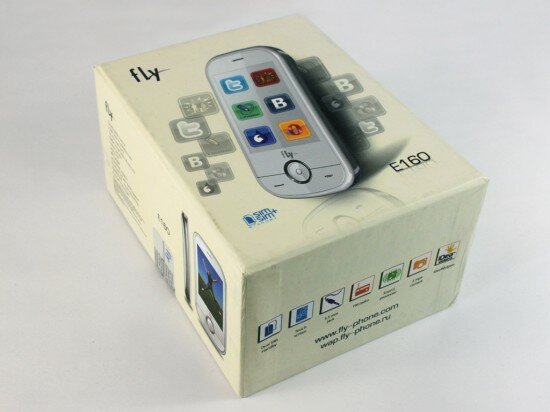
Pic. 1. Package box
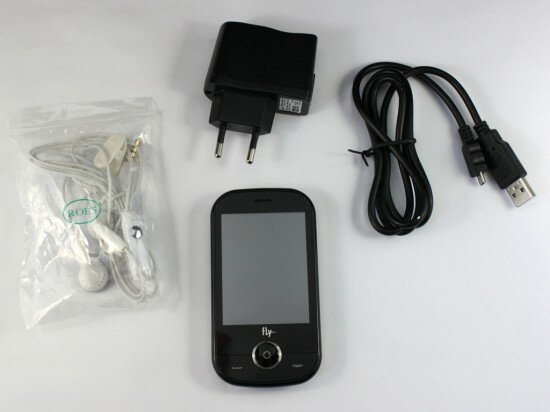
Pic. 2. Accessories

Pic. 3. Fly E160 (front panel)

Pic. 4. Fly E160 (back panel)
1. Fly E160 stress test. Stage 1 — Light shocks
1.1 Drop test
The test included two types of drops: from 1 m (3.28 ft) on the carpet with 5 mm (0.196 inches) hair height (video 1) and from 30 cm (11.8 inches) on the tile (video 2).
In both cases, the Fly E160 showed no damage due to the back cover that clung tightly to the phone.
Video 1. Drops on the carpet from 1 m (3.28 ft)
The grade is 30 (with 30 being the highest possible grade)
Video 2. Drops on the tile from 30 cm (11.8 inches)
The grade is 30 (with 30 being the highest possible grade)
1.2 Squeeze test
In this test, we found out how the chassis can withstand squeezing. We placed the Fly E160 on a table and applied a 3 kg (6.6 lbs) pressure from a wooden bar above it (Pic. 5). The gadget stayed absolutely safe.
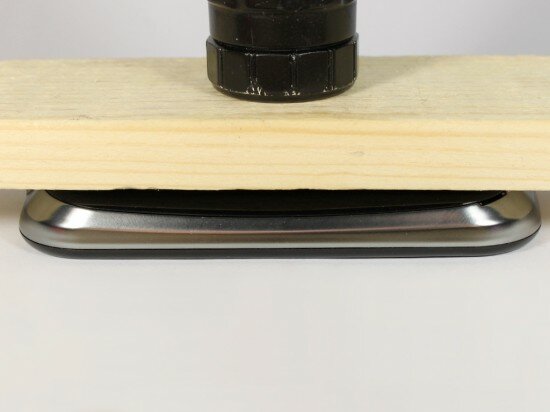
Pic. 5. The phone under the wooden bar
The grade is 24 (with 24 being the highest possible grade)
1.3 Bend test
In order to check how the Fly E160 survives bending, we did the following: we put the phone onto the two planks so that each edge of the gadget lies on a single plank. Then we hitched a string with 1 kg load (2.2 lbs) on top of the device. This test simulates a possible situation when a person sits down on a chair with his/her Fly E160 in the pants pocket. The phone seems robust and sustained no sign of bend.
The grade is 24 (with 24 being the highest possible grade)
1.4 Durability
All cell phones that are displayed in the windows of retail stores are attractive. But how will they look like after some weeks or months of everyday abuse? We hope that the test in a drum can give us the answer. The drum is devised to make the gadgets look ugly as if they are used for ages. Actually, we placed the Fly E160 inside this drum together with keys, pennies, and plastic balls to simulate what might be happening in a man’s pants pockets while carrying the phone. The drum was rotated for 5 minutes at the speed of 500 rpm (video 3).
The Fly showed good results. The chrome-effect edging of the phone didn’t sustain much damage (Pic. 6). It suffered less than we expected. However, there were some visible scuffs on it. The protective lens glass, in its turn, showed worse results, compared to the other phones that passed this test before (Pic. 7). Nevertheless, the scratches didn’t ruin the quality of the picture on the screen.
Video 3. Drum rotation
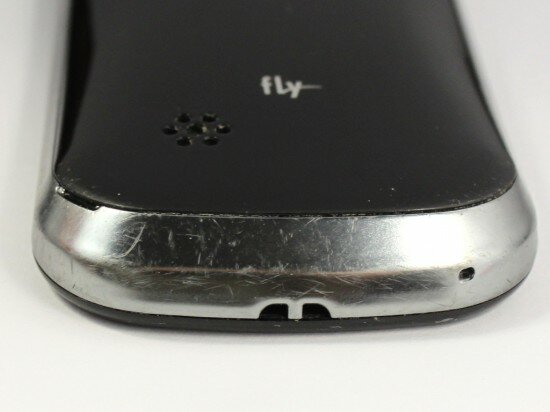
Pic. 6. Scuffs on the chrome-effect edging of the phone
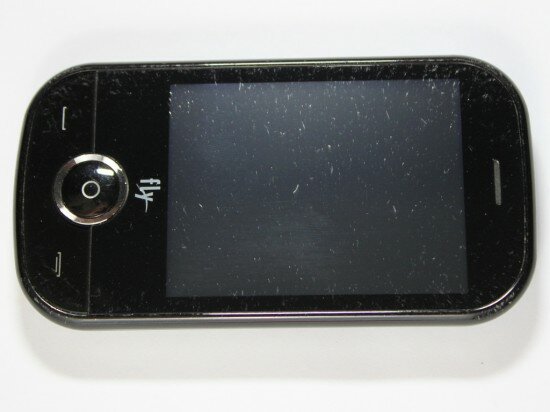
Pic. 7. Scuffs on the protective lens glass
The grade is 15 (with 15 being the highest possible grade)
1.5 Scratch test
In order to test the material of which the Fly E160 is made, we scratched the screen and the back panel with a nail fixed in a plank. The force of scratches was 100 g (0.22 lbs).
This inflicted a minor scratch on the screen (video 4). The back panel showed no scratch at all.
Video 4. Screen scratching
The screen gets 15 points (with 15 being the highest possible grade)
The back panel gets 15 points (with 15 being the highest possible grade)
1.6 High temperature
This test simulates a possible situation when a person leaves his/her cell phone in the sun or near open fire. We placed the Fly E160 in a metallic container 5 cm from the electric bulb (40 Wt). The bulb heated the phone for 3 min. (video 5). The gadget stayed attractive and performed fine after this test.
Video 5. High temperature test
The grade is 12 (with 12 being the highest possible grade)
1.7 Dust test
Dust always penetrates electronic gadgets and stays inside. Generally, it doesn’t cause any damage. However, as time goes by, more and more dirt accumulates in the devices. If dust penetrates under the protective lens glass of a mobile phone, the display quality will be diminished. But this is not the worst thing that dust can cause to a phone. It can also destroy the keys.
In order to check dust resistance of the Fly E160, we took an enclosed tray containing dirt and sand and threw the phone inside it. We made it vibrate viciously for 2 min. After the test, we examined the device.
We saw lots of sand in the large gaps between the keys and the front panel (Pic. 8). Some grains of dust penetrated under the back cover (Pic. 9). The exposed connectors were also dirty (Pic. 10).
It was easy to clean the Fly E160. The device performed fine. The keys worked without squeaks. We should say that most of the dust penetrated the phone through the ear-microphone jack because it is exposed.
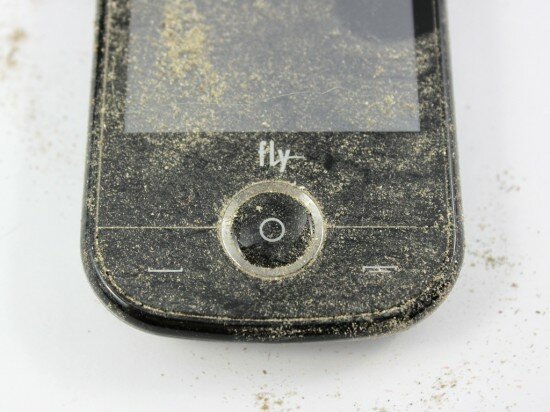
Pic. 8. Here’s how the phone looks like after all the tests
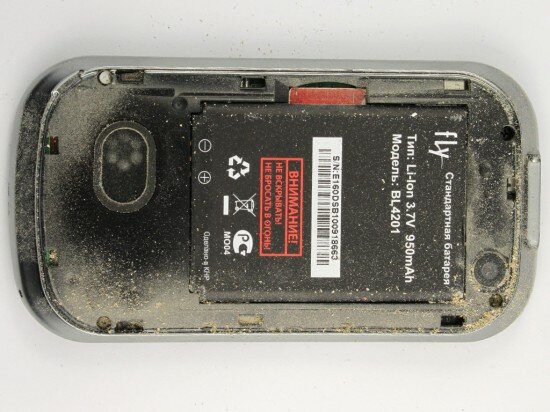
Pic. 9. Dust under the back cover
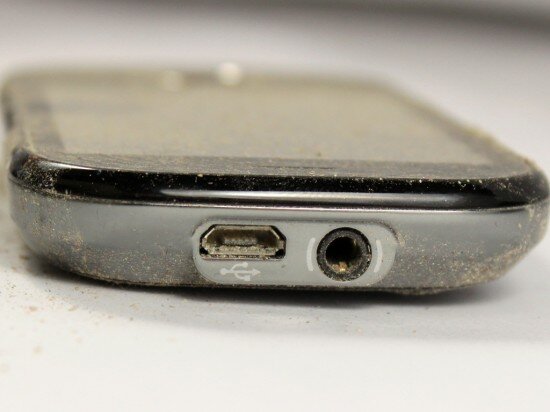
Pic. 10. Dirt in the connectors
The grade is 12 (with 12 being the highest possible grade)
1.8 Signal strength test
In order to check the performance of the Fly E160 in the areas of poor reception, we placed it inside a box. Then we foiled the box (the foil served as a shield) and made a 40 x 50 mm (1.57 x 1.97 inches) hole in it (video 6).
The signal indicator displayed only 2 bars from the maximum possible signal strength of 4. However, the phone successfully received all of the 10 incoming calls.
Video 6. Signal strength test
The grade is 15 (with 15 being the highest possible grade)
After the 1st stage of the stress tests, the Fly E160 got 192 (with 192 being the highest possible grade)
2. Fly E160 stress tests. Stage 2 — Tough conditions
2.1 Drop test
We increased the distance of the falls. We dropped the Fly E160 from 1.5 m (4.9 ft) on the carpet and from 50 cm (1.64 ft) on the tile (video 7, 8). Nothing bad happened to the phone during the drops on the tile. However, the gadget showed worse results when we dropped it on the carpet. At first, the back cover was removed several times. Secondly, the end key came out from the panel because of the bumps. We easily put it back in, but its position was not the same as it should be (Pic. 11). This inflicted a gap between the key and the front panel which spoiled the look of the Fly E160. The end key performed fine, nevertheless.
Video 7. Drops on the carpet from 1.5 m (4.9 ft)
Video 8. Drops on the tile from 50 cm (1.64 ft)
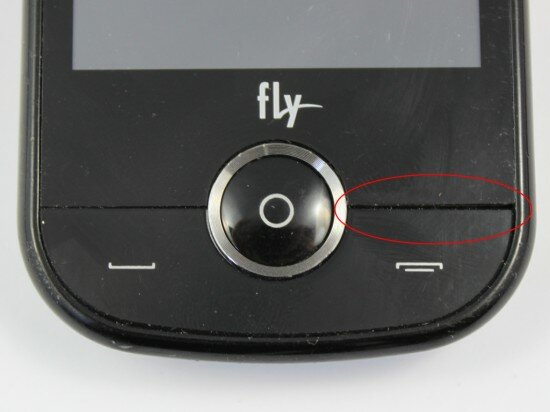
Pic. 11. Gap between the key and the front panel
The grade for the drops on the carpet is 20 (with 30 being the highest possible grade)
The grade for the drops on the tile is 30 (with 30 being the highest possible grade)
2.2 Squeeze test
We increased the applied pressure to 10 kg (22 lbs). The result was the same as in the previous squeeze test: the phone showed no damage at all.
The grade is 24 (with 24 being the highest possible grade)
2.3 Bend test
In this stage of the test, we increased the weight of the load to 5 kg (11 pounds). The Fly E160 sustained no sign of bend. We should say that a lot of cell phones showed much poorer results in this experiment.
The grade is 24 (with 24 being the highest possible grade)
2.4 Durability test
We continued making the Fly E160 look old and ugly. This time, we placed it inside the drum for 10 min. The chrome-effect was scuffed and in some parts of the edging we saw the plastic instead of the chrome-effect (Pic. 12). The glossy back cover and the protective lens glass also showed a lot of scuffs (Pic. 13, 14). Some deep scratches that appeared during this test ruined the quality of the picture.
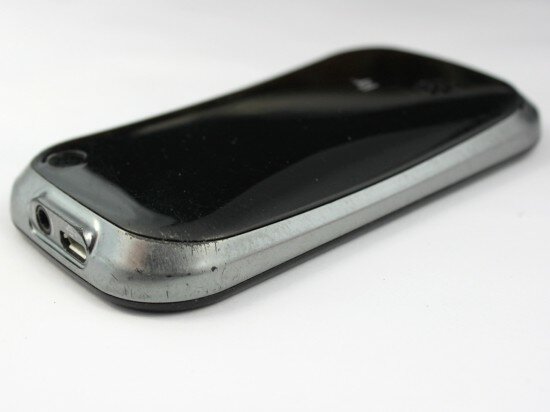
Pic. 12. Scratches on the corners of the phone
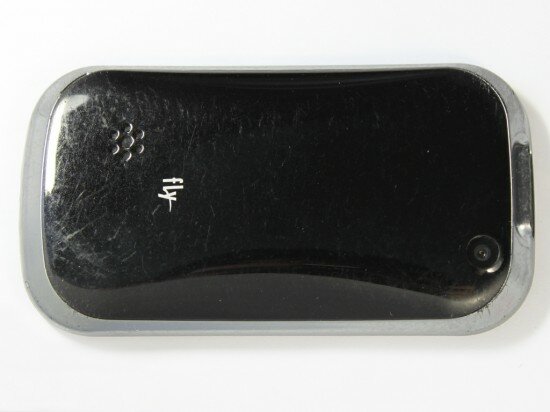
Pic. 13. Here’s how the back panel looks like after the durability test
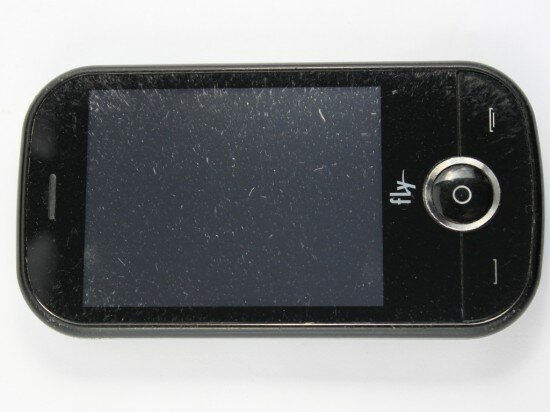
Pic. 14. Scuffs on the screen
The grade is 10 (with 15 being the highest possible grade)
2.5 Scratch test
In this test, we increased the force of scratches to 300 g (0.66 lbs). This inflicted a deep visible scratch on the screen (video 9) and a minor almost invisible scratch on the back cover (video 10).
Video 9. Screen scratching (the force of scratches is 300 g (0.66 lbs))
Video 10. Back panel scratching (the force of scratches is 300 g (0.66 lbs))
The screen gets 10 points (with 15 being the highest possible grade)
The back cover gets 15 points (with 15 being the highest possible grade)
2.6 Freeze test
Those people who happened to use their cell phones in cold weather probably had some difficulties. The capacity of the battery goes down fast, the keys become stiffer, the display malfunctions. These problems occur to any mobile phone user in winter.
In order to check the performance of the Fly E160 in such an environment, we did the following: we took a box filled with ice cubes, placed the gadget in it, and then placed the box in a freezer for 2 hours. The phone was left in speaking mode during that time. The temperature in the freezer was approximately -15 – -20 °C (+5 – -4 °F).
After the test, we examined the Fly E160 (video 11). The battery capacity stayed full. The display malfunctioned a little bit but the touchscreen was all right. The keys also worked with no problem.
Video 11. Freeze test
The grade is 18 (with 18 being the highest possible grade)
2.7 High temperature test
In this stage of the test, we increased the time of heating to 5 min. The Fly E160 stayed functional but it became too hot to handle (video 12).
Video 12. High temperature test
The grade is 12 (with 12 being the highest possible grade)
2.8 Immersion in water
There is a small chance that you drop your cell phone in water but it’s also wrong to think that it will never happen to you. Moreover, there are gadgets that can be broken just by holding them with your moist hands or using them in the rain.
In this test, we dunked the Fly E160 under water for 1 second (video 13). As you may see from the video, the battery stayed dry but the connectors became wet.
After the air drying, the phone performed fine.
Video 13. Immersion in water for 1 second
The grade is 30 (with 30 being the highest possible grade)
2.9 Dust test
We increased the time of the dust test to 5 min. As a result, we saw a lot of dirt in the gap between the front panel and the end key. This gap appeared after the drop tests when the end key came out from the panel. The position of the end key was changed. That’s why much dust penetrated under it producing an unpleasant sound when we pressed this key. The protective lens glass also let some grains of dust seep through (Pic. 15). The back cover and the connectors showed the same results as in the previous dust test.
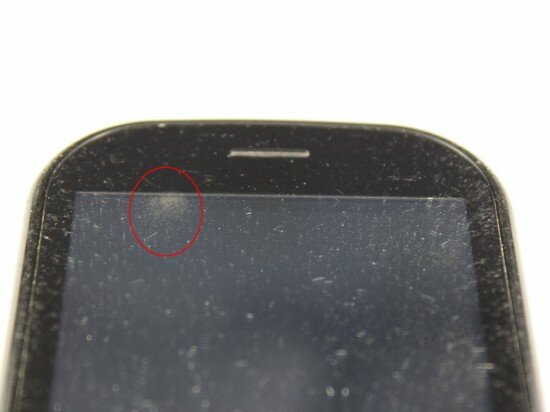
Pic. 15. Dust in the gap between the touchscreen and the display
The grade is 8 (with 12 being the highest possible grade)
2.10 Signal strength test
We placed the Fly E160 in the environment with poorer reception – in the box with 20 x 20 mm (0,787 x 0,787 inches) hole (video 14). The signal indicator displayed only 1 bar from the maximum possible signal strength of 4. However, the phone successfully received all of the 10 incoming calls.
Video 14. Signal strength test
The grade is 15 (with 15 being the highest possible grade)
After the 2nd stage of the stress tests, the Fly E160 got 216 (with 240 being the highest possible grade)
3. Fly E160 stress tests. Stage 3 — The toughest conditions
3.1 Drop test
In the 3rd stage of the drop tests, we increased the distance of the falls on the carpet to 2 m (6.56 ft) and to 1 m (3.28 ft) on the tile (video 15, 16).
This time, the results of the drops on the carpet were different from the previous drop test: the back cover stayed in its place and the keys were fine. However, during the drops on the tile, the end key came out again. The back cover still clung tightly to the phone but it became a little bit deformed after the bumps. As a result, we saw a gap between the back cover and the panel (Pic. 16).
Video 15. Drop on the carpet from 2 m (6.56 ft)
Video 16. Drop on the tile from 1 m (3.28 ft)
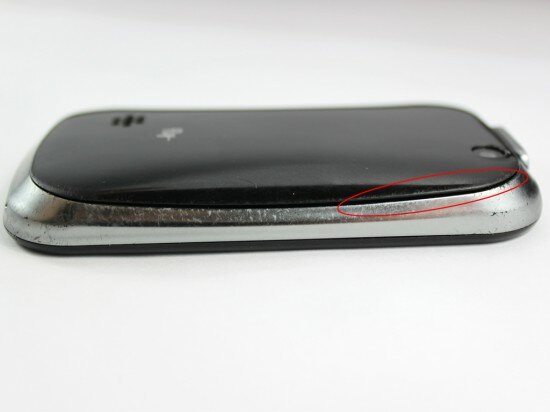
Pic. 16. The gap between the back cover and the panel
The grade for the drop on the carpet is 30 (with 30 being the highest possible grade)
The grade for the drop on the tile is 20 (with 30 being the highest possible grade)
3.2 Squeeze test
In this test, we increased the pressure we applied to 20 kg (44 lbs). This made the back cover cling more tightly to the phone and that’s all. The Fly E160 showed no visible damage.
The grade is 24 (with 24 being the highest possible grade)
3.3 Bend test
We applied 10 kg (22 lbs) weight in our 3rd attempt to bend the Fly E160. Unfortunately, this time, we saw a slight bend (Pic. 17). But the phone stayed functional.
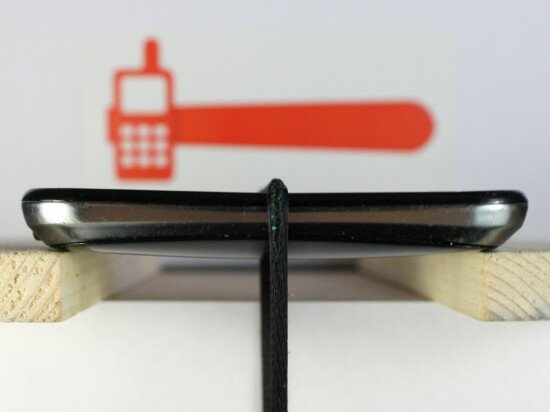
Pic. 17. Bend made by the 10 kg (22 lbs) load
The grade is 24 (with 24 being the highest possible grade)
3.4 Durability
By the time we placed the Fly E160 inside the drum for the 3rd time, the phone already looked like an ugly piece of hardware. However, we increased the time of this experiment to 20 min.
As a result, the chrome-effect edging showed much more damage, compared to the previous tests (Pic. 18). There were lots of scuffs. The edging became plastic. The chrome-effect was almost gone. The scratches ruined the picture on the screen even more than the previous time (Pic. 19).
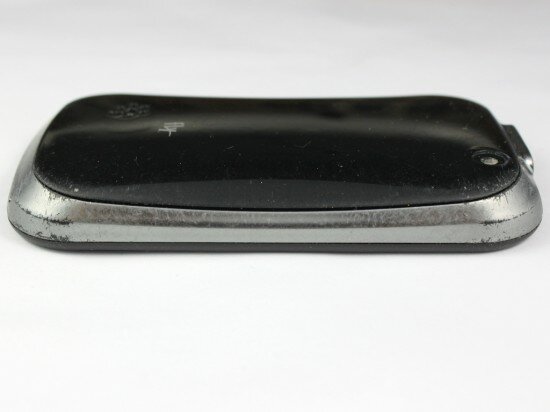
Pic. 18. Scuffs on the chrome-effect edging
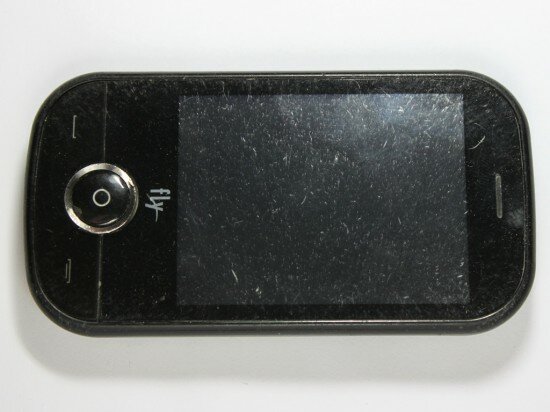
Pic. 19. Scuffs on the touchscreen
The grade is 10 (with 15 being the highest possible grade)
3.5 Scratch test
This time, we increased the force of scratches to 600 g (1.322 lbs). The screen sustained a deep visible scratch (Pic. 20, 21 video 17). The scratch on the back cover was also deep but it wasn’t much bigger than the scratches inflicted during the durability tests (Pic. 22, video 18).
Video 17. Screen scratching
Video 18. Back panel scratching

Pic. 20. Scratches on the screen
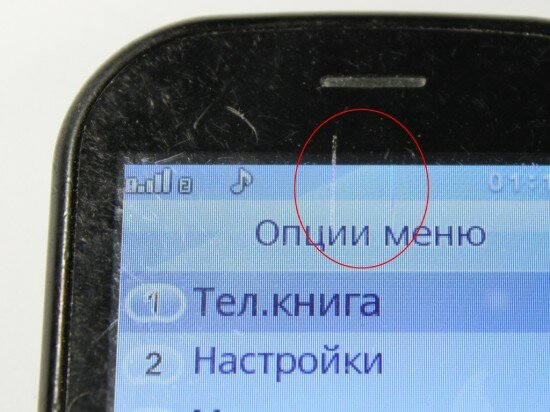
Pic. 21. That’s how the quality of the picture is ruined
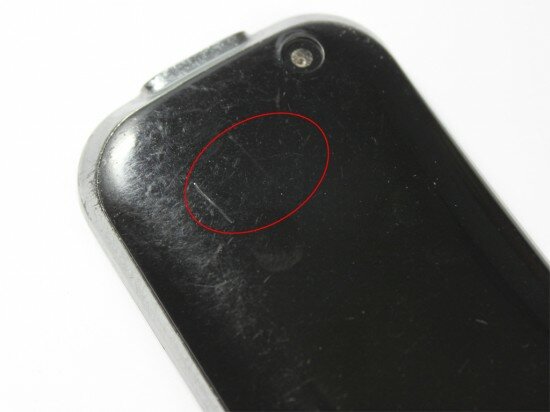
Pic. 22. Scratches on the back panel
10 points for the screen (with 15 being the highest possible grade) for the screen
10 points for the back cover (with 15 being the highest possible grade) for the back cover
3.6 High temperature test
In the previous stage of this test, the phone was exposed to heat for 5 min. and stayed fine. This time, we increased the time of this experiment to 10 min. As a result, the display of the Fly E160 became dim but soon it restored its brightness (video 19). However, the edges of the menu key melted (Pic.23). This made the phone look even uglier. The call/end keys also melted a little bit. When the temperature of the Fly E160 became normal, it performed pretty fine, despite the destroyed keys.
Video 19. High temperature test
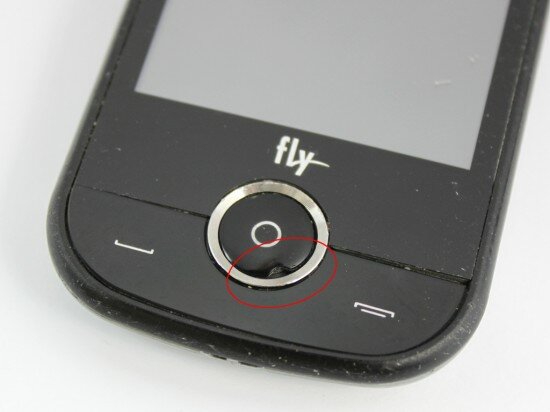
Pic.23. Melted menu key
The grade is 8 (with 12 being the highest possible grade)
3.7 Immersion in water
This is the 2nd stage of the water test. This time, we dunked the Fly E160 under water for 20 seconds (video 20). Despite the circuit board got wet, the phone stayed functional (Pic. 24). We think that water penetrated the phone through the back cover that was no more reliable after the bumps. But we can also agree that water could penetrate the phone through the exposed connectors.
Anyway, the air drying for an hour helped the Fly E160 to recover and the phone performed fine afterwards.
Video 20. Immersion in water for 20 seconds
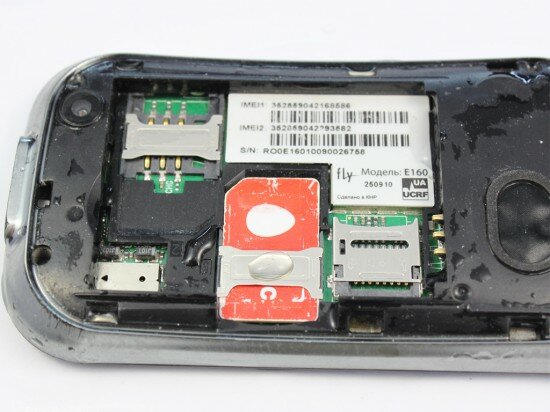
Pic. 24. The battery and the circuit board got wet
The grade is 30 (with 30 being the highest possible grade)
3.8 Immersion in beer
According to our tradition, we dunk cell phones not only under water but also under beer. In this test, the immersion in beer lasted 10 seconds (video 21).
The beer had a different impact on the Fly E160 than water. When we took the phone out and examined it, the device switched itself off. We removed the battery and saw the evidence of beer in the phone. It means that the circuit board got wet again.
We washed and dried the Fly E160 for an hour but the gadget refused to start working. We increased the time of the air drying and in a few hours the phone performed fine again.
Video 21. Immersion in beer for 10 seconds
The grade is 6 (with 9 being the highest possible grade)
3.9 Dust test
In the last stage of this test, we vibrated the tray containing dust and the Fly E160 for 10 min. During the vibration, the back cover was removed (Pic. 25). The battery stayed in its slot, though. Do we need to say that a lot of dust penetrated the phone (Pic. 26)? The USB port was so dirty that it was impossible to plug in the cable. It certainly needed cleaning.
The end key started to produce the unpleasant sound again. The protective lens glass let more dust seep through. Some grains of dust penetrated even under the camera lens. We didn’t witness such damage in the previous durability tests.
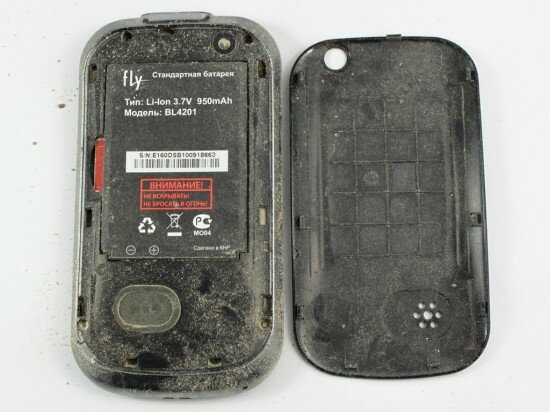
Pic. 25. Here's how the gadget looks like after this test

Pic. 26. Dust in the battery slot
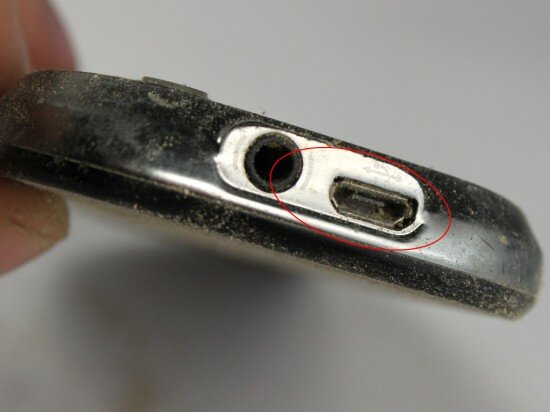
Pic. 27. Dirty USB port
The grade is 8 (with 12 being the highest possible grade)
3.10 The keyboard
The keypad of the Fly E160 consists of only 3 hardware keys which are not durable at all. The design of the keypad also sucks. The phone is made of a low quality plastic that can melt and become less attractive. The gaps between the keys and the front panel say “you’re welcome” to dust and dirt that can destroy the keys. The keys may also come out from the panel if you accidentally bump your Fly E160.
However, the keypad performed fine in cold weather. This is their only advantage.
The grade is 10 (with 15 being the highest possible grade)
3.11 Signal strength test
We decreased the size of the hole in the shielded box to 15 x 15 mm (0,59 x 0,59 inches). The indicator of signal strength displayed only 1 point from the maximum possible signal strength of 4 (video 22). However, the handset received all of the 10 incoming calls.
Video 22. Signal strength test
The grade is 15 (with 15 being the highest possible grade)
3.12 Short circuit and overcharge
At first, we wanted to know what would happen to the battery charger if we made a short circuit of the power supply terminals with the help of the forceps for 1 second. Watch video 23 to witness how it did not break the battery charger.
Video 23. Short circuit of the battery charger
In order to check the quality of the battery protection, we made a short circuit of the power supply terminals with the help of the forceps for 1 second (video 24). After this test, the phone performed fine. The battery that stayed full.
Video 24. Short circuit of the battery
Next, we found out the minimal charging voltage and how the Fly E160 can withstand the increase in charging voltage.
We plugged the battery charger in the PSU (video 25). The PSU was plugged in the phone. We started to increase the voltage. The charging was stopped at 7.1 V which is a good result.
The result of the decrease in charging voltage was also fine. However, the phone identified the USB cable instead of the charger. This shouldn’t have happened.
Video 25. Increase/decrease in charging voltage
Finally, we examined the phone’s reaction to the increase in energy supply. We plugged the PSU in the phone instead of the battery and started to increase the energy supply until we reached 7 V (video 26). The Fly E160 stayed functional, though the energy consumption increased by 11 times (from 55 mA to 550 mA). It means that this phone is not produced to withstand such overcharge.
Video 26. Increase/decrease in energy supply
For the ability to withstand short circuits the battery charger gets 15 (with 15 being the highest possible grade)
For the ability to withstand short circuits the battery gets 15 (with 15 being the highest possible grade)
For the ability to withstand increase/decrease in charging voltage the Fly E160 gets 10 (with 15 being the highest possible grade)
For the ability to withstand increase/decrease in energy supply the Fly E160 gets 10 (with 15 being the highest possible grade)
3.13 Disassembling
After all the stress tests, we disassembled the Fly E160 (Pic. 28). We have never tested a cell phone with such a poor build quality. This handset reminded us about the fake smartphones, produced in China. The display and the touchscreen, for example, are soldered to the circuit board. This makes it difficult to disassemble the phone and to replace the touchscreen. By the way, the loop of the touchscreen was caught between the circuit board and the antenna. As a result, the loop deformed a little bit. Perhaps, this is the only flaw of the Fly engineers, but this is a very serious disadvantage.
All the metallic shields of the circuit board are non-removable. However, the circuit board seems reliable and compact if you don’t pay attention to its cheap components (mini-jack, SIM card slots and the power supply terminals).
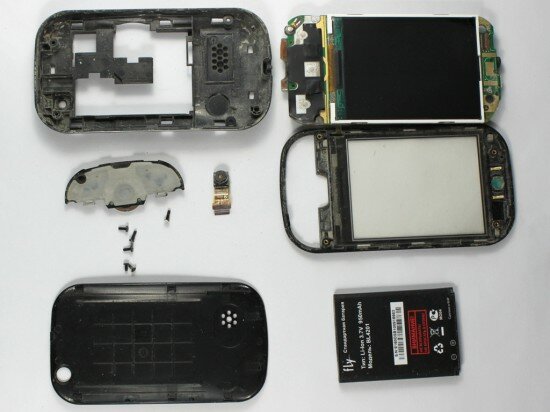
Pic. 28. The Fly E160 disassembled
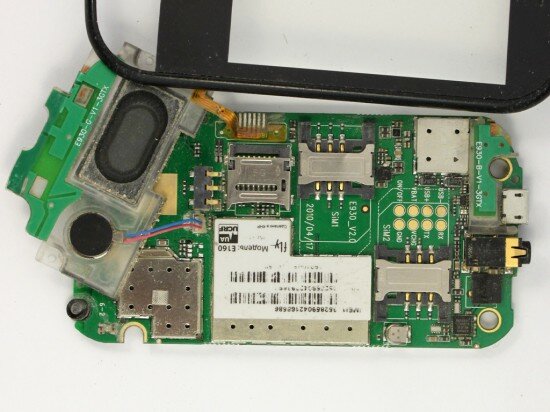
Pic. 29. The Fly E160 circuit board
The grade is 5 (with 15 being the highest possible grade)
After the 3rd stage of the stress tests, the Fly E160 got 275 points (with 351 being the highest possible grade)
Conclusion:
Summing up the results of the Fly E160 stress tests, we’d like to mention the disadvantages, at first. We are really disappointed with this phone. The poor quality material of the keypad makes the gadget unreliable in use. The keys came out from the panel during the drop tests. Dust and dirt had a bad impact on their performance too. The keys melted because of the heat from the electric bulb. In cold weather, however, the keys and the touchscreen work fine. Nevertheless, the display malfunctioned. If it was colder, for example, – 30 °C (-22 °F), the performance of the Fly E160 would be very poor.
The device is neither dust nor water resistant: dirt and liquids penetrate the phone with no problem. The panels and the screen sustained too many scuffs and scratches during the tests. The build quality and the material of which the gadget is made leave much to be desired.
We mentioned so many drawbacks of this model that it’s hard to believe that there are some advantages. But there are some! The signal strength of the Fly E160 is pretty fine. Dual SIM card capability is a very import feature for many mobile phone users. The robust chassis makes the Fly E160 resistant to all possible bends.
Here’s how the phone looks like after all the tests (Pic. 30, 31, video 27).
Video 27. Here’s how the phone looks like after all the tests
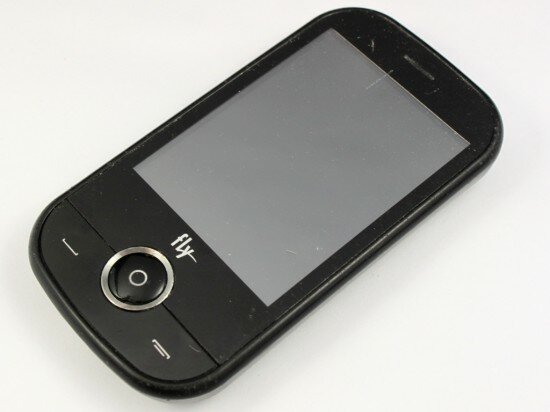
Pic. 30. Here's how the front panel of the Fly E160 looks like after all the tests
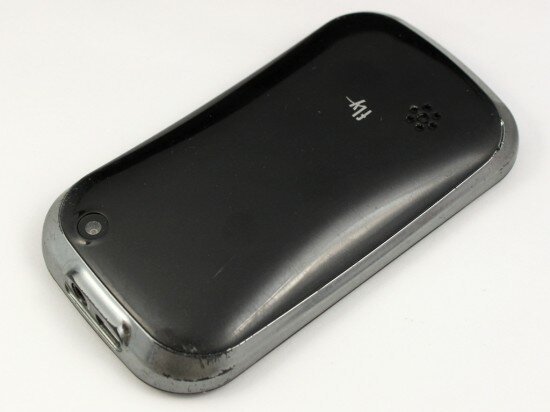
Pic. 31. Here's how the back panel of the Fly E160 looks like after all the tests

 Russian version
Russian version
Trackback/Pingback (1)
[...] we have tested a dual SIM touchscreen cell phone for the first time. It was the Fly E160. Today, in our lab, we are going to abuse a handset with almost the same specifications: the [...]